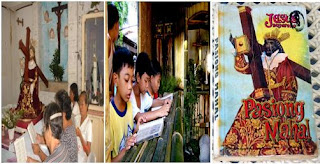
The Filipino culture of celebrating Lent is a galactic extreme apart from the rest of the world, and albeit sharing the Catholic Christendom with its Western counterparts in beliefs is still regarded as inveterately penitential in nature, even odd to some.
For many and even of the same flock in the RCC (Roman Catholic Church), we are still with practices and sacred traditions stuck in the Roman period.
I am quite religious, a staunch Catholic, schooled in a Catholic institution for both my grade and high school years, not your diligent daily parish church goer (but a regular Sunday and First Friday mass attendee), notably Catholic in many observances and convictions notwithstanding. My family is entirely Catholic. My almost Vatican-entrenched/bred, holier-than-thou, raised –by- Pope Pius X- and –guided- by- St.- Francis of Assisi (lol) parents served the parish as parish pastoral council presidents for several years in our village church. Mom even goes to pilgrimages in Rome and of recent in Vietnam with her friends with only prayer and fasting as her armor during these holy days. Not to be beaten is dad who is part of the lay ministers and the Knights of Columbus. Brother, a Bosconian alumni who follows St. John Bosco’s maxim “Run, jump, play BUT DO NOT SIN “, cannot last without his weekly dose of confessions to a priest. And what does that make me? Now I feel like the black sheep amongst them all, ha-ha.
Whilst in most European countries and other parts of the western world are holidaying, Filipinos find these things as a mortal sin. You will surely be met with utter disdain for such irreverence! Being extra careful driving as one is more possible to bleed from a cut and worse, meet an accident, not dancing, not even jumping nor mere playing outside the house and staying mum until Christ has risen are all just part and parcel of the whole magnification of this ecclesiastical celebration that we call as LENT.
I also grew up with these practices that others consider as myths. And although (some of) these antiquated and severely Catholic Filipino practices have gone to modified charters, adapting to contemporary times, they are still practiced nonetheless. Only in the Philippines will you hear Filipino people reprimand you for taking a bath on a HOLY WEEK particularly on a Maundy Thursday (Holy Thursday) and a Good Friday. Loud music is met with frustrated consternation from the oldies. Most Catholics, as a form of penitence, undergo the hypoglycemic ordeal of fasting. Eating pork is a no-no and you will be no sacred cow to the constant berating of manangs and manongs if you don’t take these traditions seriously.
Your next door manangs doing the marathon singing of the PABASA in front of an image of Jesus the Nazarene. Kids chanting the PASYON whilst standing on a make -shift altar. An image of the PASYONG MAHAL book of PASYON - the book the beckons many devotees.
The sedate Holy Week tradition and practices in the Philippines is made more interesting with another unique embellishment --- the PABASA. Singing in that distinct arcane and exotic provincial tune, the laity of the church (usually your next door manangs and manongs, no offense meant) set up an altar in their village, some making their homes as the place for this ritual or even the church and chants tirelessly from Holy Wednesday until Good Friday the entire book of the Passion and Death of Jesus Christ known as PASYON, of which contents lifted from the Holy Bible depicts the life and death of Jesus Christ. Some Filipinos consider this tradition as central to the faith for it indoctrinates the people about the redemptive act of Jesus Christ’s bloody and harrowing brutal death.
Holy Thursday, Good Friday and Black Saturday must, for very obvious reasons, be spent in a sacrosanct fashion – set for mourning, literally. Expect businesses to be closed . The media in the Philippines is in a low-keyed mood . Music stations follow suit as well to pay respect : no upbeat music and comedy programs. Should you decide to listen otherwise to something not mellow, better jettison the idea as not only would oldies (that includes your parents, your friends’ parents, your uncles and aunts, your grandparents and the whole Catholic lineage) reprimand you, but you might as well experience a harangue of sorts form your laity and parish priest (lol). Actions and environment must ideally emblematize the Lenten season. And hey, oops? I say these things with sincere jest, not to mock the practice.
LENT IN THE PHILIPPINES
The re-enactment of Jesus Christ’s flagellation and crucifixion is still vibrantly welcomed in the only Christian country in Asia. Spain’s Semana Santa will certainly be put to a disgrace and I am cocksure that the German Pope will suffer a transient loss of consciousness if he chanced upon to witness this unbelievable event.
I regard these practices though as sacred in memoriam of the Passion and Death of our Lord, Jesus Christ.
WARNING : GRAPHIC IMAGES BELOW
One brave man subjecting himself to the whole enchilada of the re-enactment of the 14 stations --- crucifixion included! A familiar Lenten practice in the whole of Pampanga, this poor (but brave) man, one among those many who have undergone penitential acts is being nailed --- and with that grotesque size of a nail! And yes, you see blood , the picture isn't lying.
Passion Sunday, as it must be addressed properly (known to most as Palm Sunday) is good business for palm decorators. Here, a woman palm peddler sells her palms ( and other native tree branches) which are considered staples at the Sunday before Easter Sunday. Palm branches are used as a tool to commemorate the time when Jesus was welcomed warmly in Jerusalem , a week before his passion and death. I still prefer the original palm branch (sitting on the lavender pail) but since procurement of palms isn’t an easy task, palm peddlers usually make native tree branches as ready substitutes.
Recently, an Australian (John Michael) local subjected himself to crucifixion when he played as Jesus. When asked why he would do such a courageous and heroic act, he did not offer a reply. His companion however said it's something personal for John.

Pampanga could well be a UNESCO World Heritage Site (lol) for being the bloodiest place when the Lenten season hits. Gua-Gua, Cutud and San Fernando- all places from Pampanga where actual re-enactment take place draw a legion of crowds.
These crucifixion and flagellation re-enactment rituals are devoutly and yet to some, sanctimoniously observed all throughout the country particularly in the provinces. Urbanized areas and cities as well practice such but without much ado the way provincial people exhibit. The Filipino men, subjecting themselves to this ordeal genuinely believes that by doing the act, their sins are washed away; forgiven. Believe me or not, this most popular Holy Week Lenten celebration draws a sizable crowd of a grand mix- curious - not-the-faint-at heart foreigners/tourists, street people ( tambays as what we call them here in the Philippines), the educated, uneducated and those in the higher echelons even.
The Philippines is predominantly Catholic in belief and thus, citizens would always participate in religious activities that serve as the ladder closer to God. Catholics not only believe in just THE WORD but treat sacred traditions as integral to the faith. We regard the mass as the highest form of prayer for in this celebration, the mystical body of Christ is transformed into the actual body and blood of Christ. Remembering the passion and death of Jesus Christ in order to liberate us sinners from tribulations is also experienced with every mass celebrated. I am fully aware that many, from the other sects of Christianity will find these Catholic dogmas contentious and say ”Oh come on, that is blind faith”. In my book, what makes faith blind is when one relies only on what is seen.
Like the wind, we believe in that presence for we experience it in our lives. And like Christ’s faithful followers some 2000 years ago, we (should) become as the modern day Pauls, Johns, Peters and the rest of His disciples whose works to propagate the universal Catholic faith must be extended in our bleak spirited and hedonistic world.




